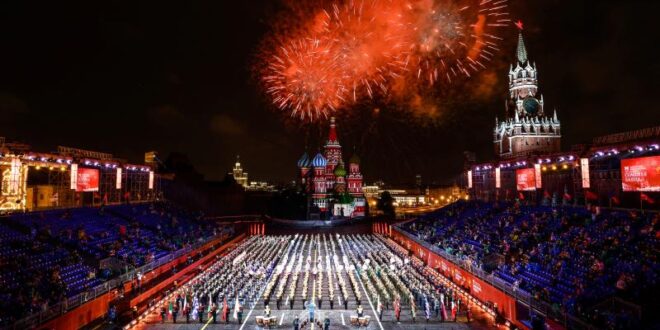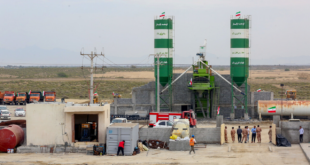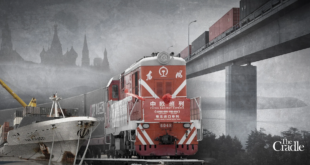The Biden administration came into office with a clear and unambiguous foreign policy priority: countering a rising China. The administration’s public statements, its early national security planning documents, and its initial diplomatic forays have all suggested that pushing back against Beijing’s growing global influence will be Washington’s national security focus, alongside transnational threats such as climate change and the COVID-19 pandemic. The question of how to deal with Russia, by contrast, has taken a back seat, returning to the fore only when Russian troops amassed on Ukraine’s border in April. That crisis served as a reminder of the danger of looking past Moscow—yet by July, President Joe Biden was back to declaring that Russia was “sitting on top of an economy that has nuclear weapons and oil wells and nothing else.”
Biden is not the first American leader to think along these lines. Ever since the end of the Cold War, American politicians have periodically suggested that Russia’s days as a true global power are numbered. In 2014, John McCain, a Republican senator from Arizona, called Russia a “gas station masquerading as a country.” That same year, U.S. President Barack Obama dismissed Russia as a mere “regional power.” Not long thereafter, Russia successfully intervened in the Syrian war, interfered in the 2016 U.S. presidential election, and inserted itself into the political crisis in Venezuela and the civil war in Libya. And yet, the perception of Russia as a paper tiger persists.
The problem is that the case for Russian decline is overstated. Much of the evidence for it, such as Russia’s shrinking population and its resource-dependent economy, is not as consequential for the Kremlin as many in Washington assume. Nor should the United States expect that Russia will automatically abandon its course of confrontation once President Vladimir Putin leaves office. Putin’s foreign policy enjoys widespread support among the country’s ruling elite, and his legacy will include a thicket of unresolved disputes, chief among them that over the annexation of Crimea. Any disagreements with the United States are here to stay.
Put simply, Washington cannot afford to fixate on China while hoping to simply wait Russia out. Rather than viewing Russia as a declining power, U.S. leaders should see it as a persistent one—and have a frank conversation about the country’s true capabilities and vulnerabilities. Rethinking American assumptions about Russian power would allow policymakers to address what will be a period of prolonged confrontation with a capable adversary.
FAULTY ASSUMPTIONS
Expectations of Russian decline contain important truths. The country’s economy is stagnant, with few sources of value other than the extraction and export of natural resources. The entire system is rife with corruption and dominated by inefficient state-owned or state-controlled enterprises, and international sanctions limit access to capital and technology. Russia struggles to develop, retain, and attract talent; the state chronically underfunds scientific research; and bureaucratic mismanagement hinders technological innovation. As a result, Russia lags considerably behind the United States and China in most metrics of scientific and technological development. Military spending has largely plateaued in the last four years, and the population is forecast to decline by ten million people by 2050.
With such a dismal outlook, it is natural to assume that Russia’s capacity for disruption and hostility on the international stage will soon diminish, too—that the Kremlin will simply run out of resources for its aggressive foreign policy. But those data points miss the broader picture. They highlight Russia’s weaknesses and downplay its strengths. Russia may be “a downshifter country,” as Herman Gref, the head of Russia’s largest bank, complained in 2016. But its economic, demographic, and military potential will remain substantial, rather than entering a precipitous decline.
Consider the country’s economy, which, stagnant as it may be, is still larger and more resilient than many believe. Analysts like to point out that Russia’s GDP of $1.5 trillion is comparable to that of Italy or Texas. But that $1.5 trillion is calculated using market exchange rates. Factor in purchasing power parity, and it balloons to $4.1 trillion, which would make Russia the second-largest economy in Europe and the sixth-largest in the world. Neither measure is wholly accurate—one is likely an underestimate, the other an overestimate—but the comparison shows that Russia’s economy is nowhere near as small as the conventional wisdom holds. At any rate, raw GDP is often a poor measure of geopolitical power: it no longer translates easily into military potential or international influence.
Washington cannot afford to fixate on China while hoping to simply wait Russia out.
To be sure, Russia’s economy has not been kind to its citizens. Real disposable incomes are ten percent lower today than they were in 2013, wiping out nearly a decade of growth. But macroeconomic indicators are stable enough to allow Moscow to project power well into the future. After Russia’s annexation of Crimea and occupation of eastern Ukraine in 2014, international sanctions and falling oil prices caused its economy to tumble. In the years since, however, the government has reined in its spending and adapted to lower oil prices, creating budget surpluses and a growing war chest. The latest estimates, as of August 2021, put the value of Russia’s National Wealth Fund at about $185 billion and its foreign currency reserves at $615 billion—hardly a picture of destitution. A new policy of import substitution, devised in response to international sanctions, has breathed new life into the agricultural sector, whose exports now rake in more than $30 billion annually. The Kremlin has also reoriented trade away from the West and toward China, currently its number one trading partner. Trade with China is expected to exceed $200 billion by 2024, twice what it was in 2013.
What of Russia’s dependence on extractive industries? Oil and gas sales continue to account for about 30–40 percent of the government’s budget, meaning that a future shift away from fossil fuels will sting. But it is unclear how near that future really is. And Russia produces energy at such a low price that other exporting countries are likely to get squeezed well before it sees its budget crimped. In addition, Russia is the main energy supplier to the European Union, whose dependency has only grown over the past decade: the EU gets 41 percent of its natural gas, 27 percent of its oil, and 47 percent of its solid fossil fuels from Russia. The problem Moscow faces is that its resources are not infinite. Russia’s oil production will peak in the coming decade—some think it may have done so already—meaning that the country’s capacity to export easily extractable (and thus cheap) oil will hit a ceiling.
Meanwhile, although Russia lags behind the United States in technological innovation, it still ranks among the top ten worldwide in research-and-development spending. In the case of artificial intelligence, it may not even matter whether the country is a leader or a follower: given the many applications and the commercial utility of this technology, Moscow will likely realize some second-mover advantages while letting the United States and China take on the costs and risks of pioneering its development. Moreover, Russia has a struggling but viable technology sector and has developed its own analogs to Facebook, Google, and other popular online platforms, all of which are fairly successful within Russia.
OF MILITARY AND MEN
Among the most common misconceptions about Russia is that the country’s demographic outlook will dramatically constrain its future capabilities. Such demographic determinism has historically failed to predict Russia’s fortunes. According to UN forecasts, Russia’s population will shrink by about seven percent by 2050; more pessimistic projections see a decline of up to 11 percent. Even in the latter case, Russia would remain the most populous country in Europe and Eurasia by a wide margin. It may lag behind highly developed Western countries in life expectancy and mortality rates, but it has substantially narrowed those gaps since the 1990s. The country is certainly not on the brink of demographic collapse.
More important, the relevance of demographics to state power needs rethinking. Modern great powers are defined not by the size of their populations but by their populations’ quality: people’s health, educational levels, and labor productivity, among other indicators. Were it otherwise, countries such as Bangladesh, Indonesia, and Nigeria would be among the world’s most powerful states. As the American scholar Hal Brands has written, “All things equal, countries with healthy demographic profiles can create wealth more easily than their competitors.” On this front, Russia has shown considerable improvement since the 1990s, with reduced mortality, increased lifespans, and an improved fertility rate. Until 2015, it steadily rose on indexes such as the UN’s Human Development Index and the Organization for Economic Cooperation and Development’s labor productivity measures. An economic recession has since slowed down this trend, and undone some of the progress, but Russia’s overall situation has considerably improved from a demographic crisis in the 1990s and predictions of demographic doom in the early years of this century.
Brain drain remains a major problem, with many of Russia’s brightest leaving the country. Its economic impact, however, has been difficult to measure. And even as many middle-class Russians who are essential to the knowledge economy leave, Russia benefits from substantial immigration by job seekers from the former Soviet republics. Russia’s demographic profile is composed of mixed indicators that show qualitative improvements alongside quantitative decline. Meanwhile, the demographic outlooks for many of the United States’ allies and partners are equally problematic, if not more so.
MILITARY MIGHT
Above all, Russia will remain a military force to be reckoned with. Military power has historically been a Russian strength, compensating for the country’s relatively undiversified economy, technological backwardness, and lack of political dynamism. It is in part why Russia managed to sustain prolonged competitions with economically much stronger states in the past, whether it was the United States or the British Empire. After its nadir in the early post-Soviet era, Russian military power has been revived—and will only improve in the coming decade, even as American policymakers turn their attention to China.
Russia remains the United States’ primary peer in nuclear weapons technology. Aside from NATO, it also fields the strongest conventional military in Europe, reforged following a period of military reforms and investments since 2008. That transformation was largely overlooked prior to 2014, which explains why Russia’s military moves in Ukraine and, later, in Syria took many analysts by surprise. Today, the Russian military is at its highest level of readiness, mobility, and technical capability in decades. NATO remains superior on paper, but much is contingent in war, and NATO’s apparent superiority does not guarantee victory or the ability to deter Russia across the range of possible conflicts. Russia also fields a flexible array of special forces, mercenaries, and military intelligence operatives. This is before considering the country’s status as a leading power in space or its extensive cyberwarfare capabilities, which were recently demonstrated by the so-called SolarWinds breach, in which Russian hackers penetrated and spied on several U.S. government agencies.
Adjusting for purchasing power parity and for the peculiarities of autarkic defense sectors such as Russia’s, analysts have estimated that Russia spends somewhere between $150 billion and $180 billion per year on defense, considerably more than the market exchange rate figure of $58 billion suggests. Half of Russia’s annual defense budget is spent on procuring new weapons, modernizing old ones, and researching military technology, which is a far greater share than is spent in these areas by most Western militaries. Those, moreover, are conservative estimates, since some Russian expenditures remain hidden, obscured, or classified. Using these generous budgets, the Russian military-industrial complex has developed many next-generation weapons, from hypersonic missiles to directed-energy weapons (such as lasers), electronic warfare systems, advanced submarines, and integrated air defenses, along with antisatellite weapons of various types.
The Russian military is not without its problems and remains a laggard in some areas. In practice, however, Russia is well positioned to remain a dominant actor in the post-Soviet space and to challenge U.S. interests in other regions, such as the Middle East. Russia retains the airlift and sealift capabilities needed to deploy its troops at some distance from its borders. Its defense spending looks stable at current levels, despite the triple shock of an economic recession, low oil prices, and international sanctions. The Russian military still sees itself as a relative underdog, but it has grown more confident that it can deter NATO even without nuclear weapons, and the outcome of a prolonged war between Russian and NATO forces is difficult to predict. Under these circumstances, the United States and its allies should stop dismissing Russia as a mere “disrupter” and recognize it as a serious military adversary in both ability and intent.
IT’S NOT JUST A PUTIN PROBLEM
Tied up in the narrative of Russian decline is the notion that the United States primarily has a Putin problem—that once the Russian president leaves office, his country’s foreign policy will grow less assertive. Yet that is unlikely to be the case. For one thing, Putin can legally remain in office until 2036, thanks to a referendum that he pushed through last year that allows him to serve two more six-year terms after his current term expires in 2024. Research that one of us (Kendall-Taylor) conducted with the political scientist Erica Frantz showed that such longevity is common for leaders like the Russian president. In the post–Cold War era, autocrats who, like Putin, had made it to 20 years in office, were at least 65 years of age, and had concentrated power in their own hands ended up ruling for 36 years, on average.
Research on longtime authoritarian leaders also suggests that once Putin does depart—even if earlier than expected—there will be little prospect for substantial political improvement. Most often, the regimes that such longtime leaders create persist, or a different dictatorship emerges. The odds that democratization will follow a regime like Putin’s—run by an older, personalist leader who has clung to power for 20 years or more—are less than one in ten. Extending term limits, as Putin did after last year’s referendum, is also a bad sign. According to data from the Comparative Constitutions Project, 13 leaders around the world pursued term-limit extensions in the period from 1992 to 2009. In all but one case, their regimes either are still in power or simply transitioned to a new authoritarian regime after the leader’s departure.
This is not to suggest that Russia is doomed to authoritarianism or that a change in the president would not matter. Nonetheless, the empirical record shows that the actions longtime authoritarian leaders typically take to ensure control—such as undermining civil society and hollowing out institutions that could constrain their power—create barriers to the emergence of democracy. Likewise, a mere change in leadership would likely matter only at the margins. Unless Putin’s departure ushers in a significant turnover in the ruling elite, key pillars of Russian foreign policy, such as the notion that Russia maintains the right to a sphere of influence in the post-Soviet space, will remain incompatible with the values of the United States and its allies. Simply put, American policymakers must prepare for the possibility that the contours of Russian foreign policy, and thus the Kremlin’s intent to undermine U.S. interests, will endure long after Putin leaves office.
THE PERSISTENT POWER
The United States should think of Russia not as a declining power but as a persistent one, willing and able to threaten U.S. national security interests for at least the next ten to 20 years. Even if China proves to be the more significant long-term threat, Russia will remain a long-term challenger, too—a “good enough” power, as the political scientist Kathryn Stoner has put it, with the ability to shape global affairs and substantially affect U.S. interests. The former Soviet space remains a tinderbox, still reckoning with the dissolution of the Soviet Union, which should be thought of not as an event but as a process, as the historian Serhii Plokhy has aptly put it. No matter how much Washington would like to focus on the Indo-Pacific, therefore, it must consider the prospect of another Russian-Ukrainian war, a military conflict resulting from political unrest in Belarus, or crises akin to the 2020 Nagorno-Karabakh war.
Compared with China, Russia also poses a more significant danger to the U.S. homeland. For one thing, it remains the United States’ preeminent nuclear threat, despite China’s growing arsenal of strategic nuclear weapons. The same goes for Russia’s ability to reach the continental United States with long-range conventional missiles. Russia also has more troops stationed abroad than does China, with bases in the Caucasus, Central Asia, Europe, and the Middle East, putting its military in regular proximity to U.S. and NATO forces. When it comes to indirect warfare, Moscow’s record of election interference and hacking demonstrates that it can and will employ emerging technologies against the United States and its allies. It is also worth underscoring that the Kremlin can endanger U.S. interests on the cheap. Russia’s military interventions in Ukraine, Syria, and Libya have been limited and inexpensive. So, too, are its cyberattacks and disinformation efforts.
The United States should think of Russia not as a declining power but as a persistent one.
It is perhaps in these domains—cyberwarfare and attacks on liberal democracy—where Russia is likely to pose the most sustained threat. Russia has refined a low-cost toolkit that allows it to bolster other authoritarian regimes, amplify illiberal voices in established democracies, poison information ecosystems, and subvert elections and other democratic institutions. Since Moscow believes that weakening democracy can accelerate the decline of U.S. influence, it will persist in its efforts on this front. Other states have taken note of Russia’s success in this sphere and have begun to emulate it, as shown by China’s adoption of Kremlin-style information warfare during the pandemic.
A final concern is that Moscow is increasingly finding common cause with Beijing. In effect, the two governments have formed a strategic partnership, exchanging technical and material support to offset Western pressure and focus their resources on competing with the United States rather than with each other. Their defense and military cooperation has grown, too. The impact of this alignment will be greater than the sum of its parts, amplifying the challenge to U.S. interests that each state poses individually. The challenge, therefore, will be not just properly prioritizing China and Russia in U.S. strategy but recognizing that the problems presented by the two countries are not necessarily discrete and separable.
RIGHTSIZING RUSSIA
Washington must move past the myth that Russia is a beleaguered or cornered state, lashing out in recognition of its own demise. In truth, there is little evidence that Russia’s leaders see their country in this way—on the contrary, they consider Russia to be the center of power in its own region and an assertive player globally. Events such as the bungled U.S. withdrawal from Afghanistan only reinforce Moscow’s perception that it is rather the United States that is in decline. Ignoring that view will create false expectations for Russia’s behavior, leaving the United States and its allies poorly positioned to anticipate Russian actions.
The Biden administration has taken steps in the right direction. Among them is its focus on fostering democratic resilience. By elevating cybersecurity as a national security priority, strengthening critical infrastructure, improving information ecosystems, and rooting out the corruption that Russia weaponizes to subvert democratic institutions, Washington and its allies can cut off a major source of Moscow’s influence abroad. Meanwhile, the administration’s efforts to pursue arms control and strategic stability with Russia, which should extend to cyberspace and space, will set up the necessary guardrails for a prolonged confrontation.
Moving forward, however, Washington must resist overly focusing on China to the point of neglecting other important issues, such as Russia. The Interim National Security Strategic Guidance, released in March as one of the Biden administration’s earliest national security analyses, discussed China in considerable depth while allocating barely a few sentences to Russia. Future strategic documents, such as the upcoming National Security and National Defense Strategies, should correct this imbalance.
Washington must be bolder in its efforts to defend democracy against outside subversion.
The same approach should guide the administration’s defense budgeting. The Russian military threat has not decreased, yet the funding allocated by Washington to deal with it has: successive budget requests since 2020 have cut support for the European Deterrence Initiative (a U.S. effort to bolster its military presence in Europe after Russia’s annexation of Crimea), most recently by 19 percent. Reallocating that money to East Asia, as the Biden administration wants to do, is unlikely to make a marked difference in the military balance vis-à-vis China—the amount involved is too modest for that—but it will create unnecessary risks in Europe. That is particularly true considering the possibility of simultaneous conflicts with China and Russia, in which one of those states takes advantage of a crisis involving the other to pursue its own aims. Washington must hedge against such a scenario and ensure that Europe does not become the weak link in its strategy.
NATO will play a central role in that endeavor. The alliance has recently begun updating its official guiding document, and Washington must ensure that Russia, not China, remains the clear priority. The United States should also continue to encourage its European allies and partners to shoulder more of the burden for deterrence and defense on the continent. The U.S. withdrawal from Afghanistan has reenergized European calls to enhance its own capabilities. Now is the time, through careful transatlantic coordination, for real steps toward strengthening the European pillar within NATO.
Finally, Washington must be bolder still in its efforts to defend democracy against outside subversion. The United States and its allies and partners should step up their collective responses to Moscow’s cyberwarfare, election interference, and other actions that threaten the health of their political and economic systems. They should, for example, agree to take collective action against any foreign election interference that crosses agreed-on thresholds. Russia’s digital ambitions may be overshadowed by China’s, yet Russia is developing its own brand of digital dictatorship, designed in part to undermine democracy worldwide. Addressing that threat also requires working with like-minded democratic partners in international organizations such as the International Telecommunication Union to ensure that it is not Beijing and Moscow that write the digital rules and norms of the future.
The gravitational pull of the threat posed by a rising and revisionist China is understandably strong, but the United States is capable of dealing with two powers at once: China, a pacing threat, and Russia, a persistent one. In talking about their approach to Russia, Biden administration officials are fond of saying that the United States “can walk and chew gum at the same time.” Now they will have to prove it.
 Eurasia Press & News
Eurasia Press & News




